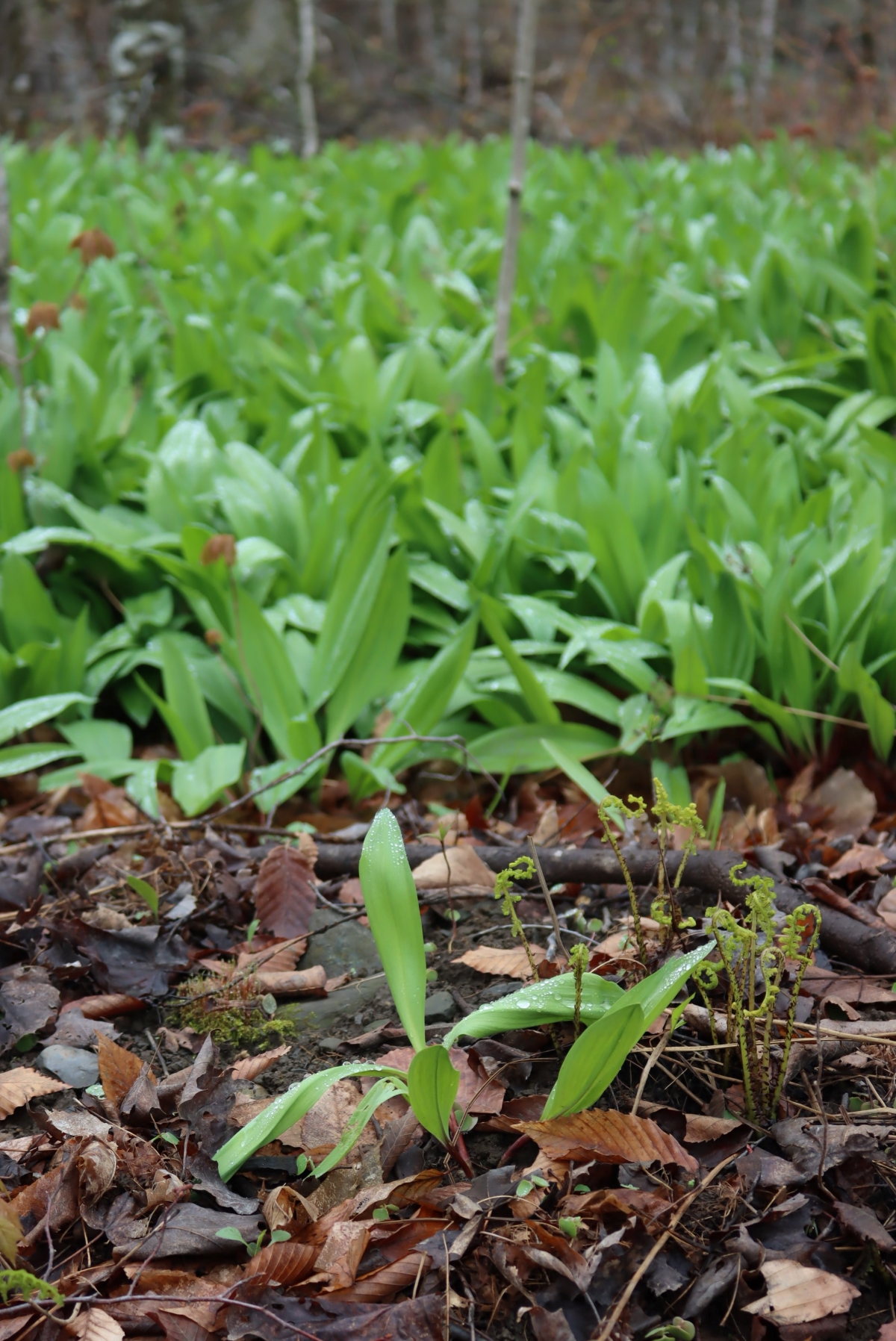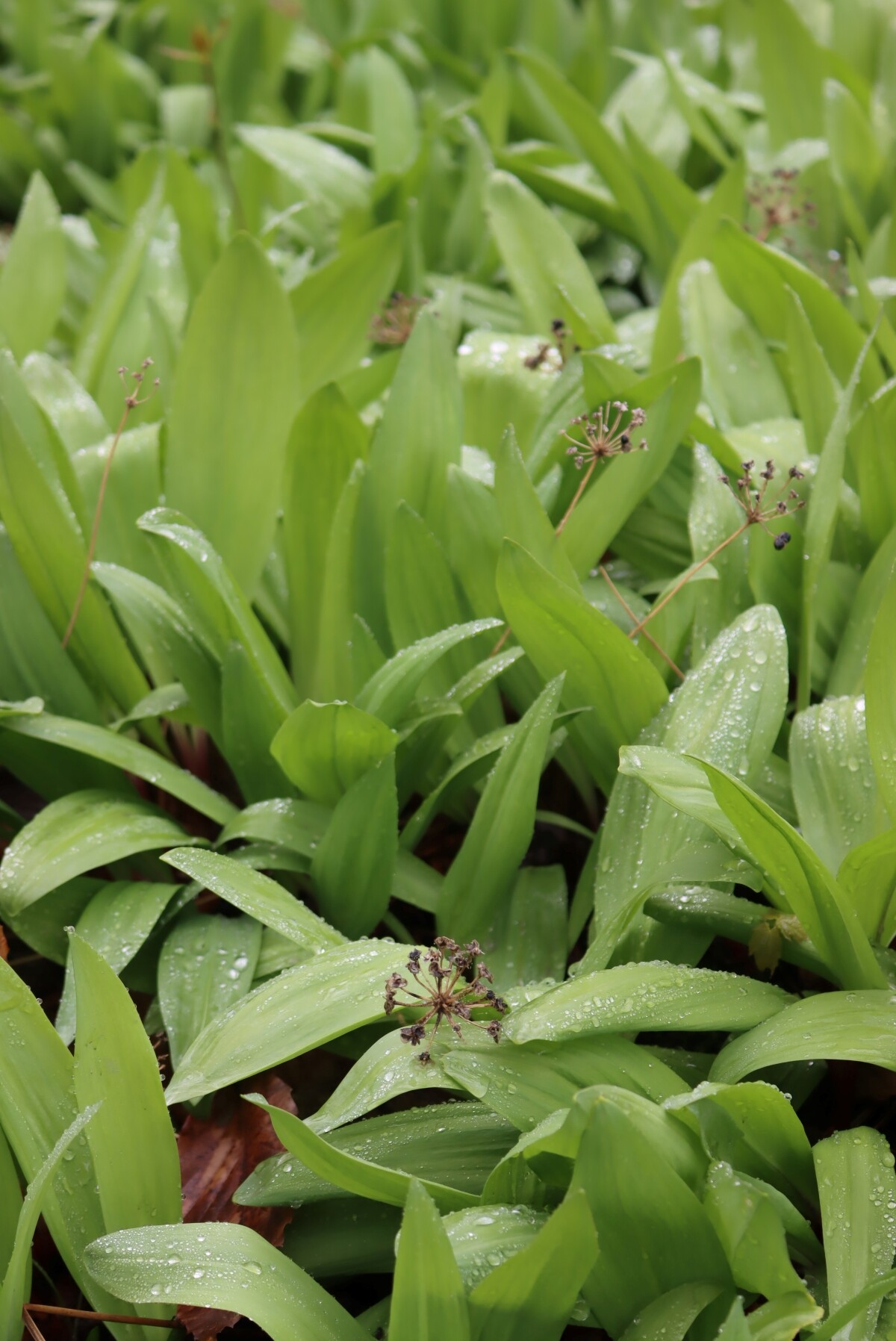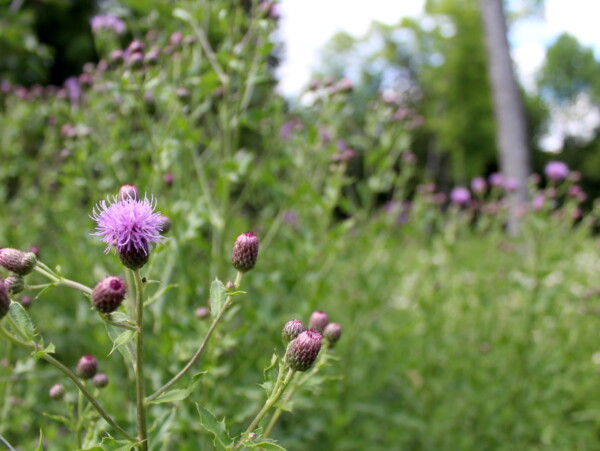Affiliate disclosure: This post may contain affiliate links. Please see our Privacy Policy.
Wild Leeks, also known as Ramps (Allium tricoccum) are a favorite of foragers in the Northeast, and they often make their way into farmer’s market stands throughout the region. Learn how to find, identify and use wild leeks, all while foraging them sustainably.

Ramps are incredibly popular with foragers and home cooks, perhaps because they’re some of the earliest spring greens. Not the earliest by far, as they in close competition with many other spring wild edibles like homemade maple syrup, marsh marigold, Japanese knotweed, dandelions, chickweed, morel mushrooms, and many others.
I imagine part of their appeal is that they’re what’s called a “spring ephemeral” which means they’re a plant that comes up early for a quick 6-8 week burst, and then they die back for the rest of the year. The foraging window is short, which makes them all the more appealing.
Add in the fact that they’ve seen a lot of press in recent years in high-profile places like the new york times, and you have an incredibly popular tiny onion…
Yes, they are more or less tiny woodland onions. Their intense peppery green onion flavor is distinctive and delicious and makes some of the best darn pesto around.
Rams are only available native to the Northeastern US, and growing up in California I’d never heard of them, but a neighbor took me foraging for Ramps shortly after I’d moved to Vermont more than 15 years ago and I’ve been hooked ever since.
You’ll often see bundles of them for sale at farmer’s markets and natural food stores in the spring (late April to Early May), where they’re sold whole (bulb and all). They’re also available online from D’artagnan and from a few shops on Etsy.
These days, with their increase in popularity and slow growth rate, it’s recommended that you only harvest the greens (leaving the bulbs to come back next year).
The leaves are by far the tastiest part, so it’s a better strategy anyway.

What are Ramps?
Ramps (wild leeks) are a slow-growing native wild edible plant that’s found in the northeastern US. They have a unique growth habit, sprouting in the early spring for a quick burst of growth before dying back for the rest of the year.
They’re known as a “spring ephemeral” which means they’re only around for a short time. They grow under mature hardwood forest canopies, and they’ll sprout before the trees have leafed in for the season. During these early few weeks, they’ll soak up as much sunlight as they can before the canopy fills in, leaving them in deep shade.
This short growth window means ramps grow very slowly, and it takes around 7 years for a ramp to reach seed-bearing age. They tend to grow in dense carpets under hardwood trees, slowly expanding the colony each year.

Native Range for Ramps
While ramps are well known throughout the US thanks to positive press, whole foods markets, and fancy food blogs, they are really only grown in the northeast. It is possible to cultivate ramps, provided you have a mature hardwood forest ecosystem with a reasonably cool winter.
(You can buy sustainably harvested ramp seeds here, if you’re interested in starting your own patch.)

That said, their native range is limited to hardwood forests of the northeastern US. They’re also found in some locations in the southern and central US (range map – zoom for detailed view by county).
Identifying Ramps
Wild leek is pretty easy to identify in my opinion. It all starts with seasonality and location. They’re only around for a short window in April and May, and will only be found under hardwood trees.
Ramps can’t compete with other plants in full sunlight, but when hardwoods provide dense shade during most of the growing season, ramps eke out an existence by soaking up all the early spring sunlight before the canopy closes.
Start by looking in hardwood stands in April and May, and they’ll usually grow in dense clusters since little else can live in this dense shade environment.

Ramp plants each have 2-3 leaves with a bright yellow/green color coming out of a red stem. Each plant is small, but it’ll look like a carpet as they grow close in colonies.
The image below shows the base of a wild leek with three leaves, along with the bright red stem leading into the ground. Below ground the perennial bulb is white (but you should leave it there).

If you do try to pull the bulb up by hand, you’ll find it’s almost impossible without a trowel. Ramps are really well-rooted and they don’t give it up easily. The tissues right at the soil level are delicate, and if you touch you can feel the outer layers slip off (like an onion with very thin layers).
Pull a bit harder and the ramp bulb will almost always break off at the soil line (unless you dig it up). That’s part of the plant’s defense mechanism, as they’re predated by deer which could easily pull them up if they didn’t break off with a gentle tug.
That ramp has worked for at least 7 years to make that bulb, so it doesn’t want to give it up easily, to humans or other animal predators.
(I mention this for practicality’s sake since it is honestly an unholy pain to harvest the bulbs, which don’t have nearly as much flavor as the leaves anyway. Stick with the leaves, it’s a more sustainable option, tastes better and it’s a lot less work!)
If the winter was relatively mild, you’ll often find ramp seed heads from the previous year still sticking up on browned stalks. The seeds themselves are shiny, black, and hard in clusters at the top of browned plant material from the previous year.
The seeds can be harvested if you want to start your own ramp patch on wooded land. (They can also be purchased here, harvested sustainably in Vermont.)

The plant’s flower after the leaves have died back, and you’ll see white flowering umbels sticking out of the ground in early summer. They usually set seed by mid to late summer, and you can go back to the ramp patch to harvest seed if you hope to establish a colony elsewhere.
Generally, the seed doesn’t travel far, and each seed head will eventually tip over to land about 8 to 12 inches from the mother plant. That’s one reason for their dense colonies, though they are spread by small mammals too.
The seed is slow to germinate, often taking well over a year, possibly because it’s often held on stiff dead seed stalks for a year or more before it eventually tips over. It’s almost as if they’re sticking out there begging something to come along, scoop up the seed and establish a new patch somewhere else.
Nonetheless, when the seed pods are persistent, it’s an easy way to help identify them. It doesn’t happen every year, and if there’s particularly windy fall weather, intense storms, or just a bad winter they may well all have hit the ground before the next foraging season comes up the following year.

The last identifier is smell…ramps have an intense onion/garlic smell that’s impossible to miss. Gently tear a leaf and it’ll be unmistakable (and your hands will smell like garlic all day).
Ramp Look-Alikes
I’ll put it out there…ramps are pretty easy to identify.
They are a low-growing green plant found under hardwoods with 2-3 bright green leaves, a red stem, and an intense onion-y scent. There’s very little that matches that description, especially in the early spring in the northeast.
That said, every spring plant identification forums are inundated with pictures asking, “Are these ramps!?!?!”
The answer most often is no…because optimistic foragers are really just hoping that anything low growing and green this time of year is actually wild leeks. I’ve seen pictures of hostas…like literally garden hostas in grandma’s flower garden misidentified as ramps (thankfully, hostas are edible too).
There are a number of early spring plants that are toxic though, so you will want to be careful.
There’s a lot of greenery out there in the early spring, more than you’d think looking at lackluster brown lawns in the suburbs that haven’t started re-growing yet. The woods are quicker to rebound, and most of the greenery out there isn’t ramps.
I’d be particularly on the lookout for Lilly of the Valley and False Hellebore, both of which are deadly toxic.
They also look a bit like the Canadian Mayflower, which has edible berries later in the season and is closely related to Solomon’s Plume, and the berries taste much the same. (I have no idea as to the edibility of the leaves in the spring, but it’s a nice thing to come back to later in the season).
Sustainable Ramp Harvesting
Ramps are incredibly well adapted to their growing niche, and they’re still quite common here in Vermont. You’ll see dense patches of them driving around country roads in the spring, especially near sugarbushes.
That’s not the case everywhere though, and in many places they’re over-harvested. They’re actually threatened in Quebec, and their harvest is regulated in some areas.
They’re relatively easy to identify and expensive to buy, so it makes sense to just take to the woods and find your own.
The problem is, you never really know how many other people are foraging a patch (even in the most remote areas). A patch might look huge, but it’s being foraged by dozens of people each year and it’s slowly shrinking given its slow growth rate.
Remember that if you pull up the whole bulb, it’s going to take a seed around 18 to 24 months to germinate and then another 7 years to mature. Pull bulbs every year and you’ll have a problem, especially if many people are harvesting the same patch.
The most sustainable way to harvest ramps is to simply harvest the leaves, and no more than one leaf from each plant. The plants each produce 2-3 leaves a year, so you’ll be able to look as you harvest to make sure there are 1 to 2 leaves remaining so that this slow-growing plant can continue to thrive.

Beyond the pure sustainability angle, there are actually a good number of reasons to harvest just the ramp leaves. The most convincing, in my opinion, is that the leaves are the tasty part.
The bulbs are fine too…but honestly nothing special. They’re more or less like a shallot, mildly onion-y with a bit of crunch. The leaves though, they’re magic. An intense flavor that’s like nothing else, and bright green color to liven up any dish.
For flavor’s sake, harvest just the leaves and then pick up a few shallots at the farmer’s market if you have a dish that calls for cooking with whole ramps.
I’m hoping that a combination of laziness (given that they’re hard to pull), sustainability concerns, and flavor would help convince you to just harvest the leaves. But if you’re still not convinced, there’s one more incredibly good reason to leave the bulbs behind.
Many of the places where ramps grow are pristine wilderness…but some aren’t!
Listening to a podcast interview with Arthur Haines, he explains yet another good reason to exercise enlightened self-interest and leave the bulbs behind:
“Many of the major rivers where wild leeks grow are also home to industrial discharges because there are factories, mills, and other such industries along with them. And many of the things that are produced for these environmental pollutants from the mills turn out to be lipophilic, in other words, they are attracted to fats. And the first place that these environmental pollutants meet up with fats in a plant is in the cell membranes of the roots. There is a lipid by-layer there. And so things like dioxin, and polychlorinated by-phenols, two great examples…they are concentrated in the soils and in the underground storage organs, which includes things like bulbs, corms, roots, and rhizomes of the plants.
Interestingly, things like PCBs are poorly translocated to the aerial portions of the plants. With a couple of exceptions, that means they’re mostly confined to the underground storage organs. Where I’m going with all this, is if you don’t know where those wild leeks were collected, it’s actually a real health insult to you to eat those bulbs because they probably represent the highest level of pollution of that plant.”
Harvesting Ramp Leaves
So even if you don’t buy the sustainability reasons to just harvest the leaves, or quite frankly, just don’t care…there are still really good reasons to stick with leaves.
- Taste better
- Easier to Harvest
- Easier to Clean
- More likely to be Free of Contaminants
Sustainably Harvesting Ramp Bulbs
Does that mean harvesting ramp bulbs is unsustainable? Not necessarily…
Not everything is quite so black and white.
If you’re harvesting a patch on your land that you know for a fact is not harvested by anyone else, and that patch is healthy and thriving, then it’s totally possible to harvest wild leek bulbs sustainably. That’s a lot of ifs…
Even still, given their low reproduction rate, sustainably means harvesting no more than around 5% of the patch on any given year. That may sound like nothing, but ramps patches can be huge.
I know someone whose been farming the same land for 50 years, and it includes a large sugarbush completely covered with wild leeks. He harvests literally hundreds of bundles each spring and sells them at the farmer’s market each year.
The patch has grown over the past 5 decades, and now he’s retiring and turning the farm (and the managed ramp patch) over to his daughter, healthier than when he started.
Just because you see whole ramps at the farmer’s market doesn’t mean they’re necessarily unsustainable, and sometimes it’s best to reserve your judgment. For all you know that vendor has been carefully managing the patch for decades, carefully stewarding it for the next generation.

Ramp Recipes
Ramp leaves have an intense flavor that’s absolutely unforgettable. If you’ve found wild ramps (or just picked them up at the local farmer’s market), you’ll want to make the most of this short-lived wild spring green.
Their spicy green flavor goes well when balanced by fats and rich dishes, and my absolute favorite ways to preserve ramps is by turning them into ramp compound butter and ramp pesto.

Beyond blending the leaves with fats in butter or olive oil-rich pesto, you can honestly use them anywhere you’d use either fresh or cooked green, or anywhere you’d like a garlic-y flavor.
Try any of these tasty ramp recipes:
- Ramp Pasta ~ The Mom 100
- Potato Salad with Ramps and Radishes ~ Relishing It
- Pizza with Ramps & Wild Mushrooms ~ Saveur
- Ramp Lasagna ~ Local Kitchen Blog
- Ramp Jam ~ Saveur
- Bacon and Ramp Viniagrette ~ Saveur
- Ramp and Mushroom Tart ~ Saveur
Ramp Bulb Recipes
If you do happen to have access to sustainably harvested whole ramps, these recipes make use of the whole plant (including the bulb).
- Grilled Ramps ~ Serious Eats
- Ramp Risotto ~ Serious Eats
- Pickled Ramps ~ Practical Self Reliance

Spring Foraging Guides
Ramps are one of the first wild edibles of spring, but they’re not the only tasty thing to find this time of year!
- Spring Foraging: 20+ Wild Edibles to Find in Spring
- 60+ Dandelion Recipes
- Foraging Morel Mushrooms
- Foraging Chickweed
- Foraging Marsh Marigold
- Foraging Plantain Herb
- Foraging Yarrow
- Foraging Nettles
- Foraging Burdock
- Foraging Japanese Knotweed





LOVE your website! Thank you. I live in Vancouver (Canada) and would love to know where I can find some ramps – we don’t have them around here wild. anyhow thank you! Is your last name really Adamant? Love it.
xo
Sharon H
PS I wrote The Book of Kale…
Here is a post all about cultivating ramps in your backyard if you can’t find them growing wild in your area.
sharon, I have purchased ramps seeds online. I planted them three years ago, a couple came up this year. They need to be stratified. strictly medicinal is the first place I look for seeds. there are plenty of other places if they are out.
My Dad grew up in the mountains of Western North Carolina, near Cherokee. He said that he hunted ramps every Spring. They had big celebrations and dinners when it was ramp season. They grew under the chestnut trees.
Thank you for this well written and most informative article. I was unaware of most of the information you have provided and I’m particularly grateful that you have spent a good amount of time reminding your readers of the importance of leaving the bulbs of the ramps in the ground and to harvest only a few leaves of each plant. Weather permitting I hope to get out this weekend to see if there are any patches of ramps in my area that I can harvest